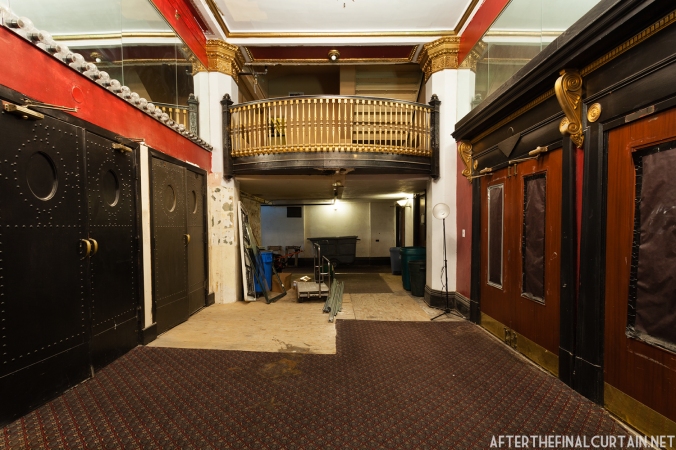The Studebaker is one of the 22 theaters in my new book “After the Final Curtain: The Fall of the American Movie Theater.” Find out more here.
Located in the Fine Arts Building in the Historic Michigan Boulevard District of Chicago, the Studebaker Theatre as it is today opened in September 1917. Built between 1885 and 1887, the building was commissioned by the Studebaker Company and designed by architect Solon S. Beman. The part of the building that would eventually become the theater was used as a showroom from 1887 until 1898 when the Studebaker Company moved to a new building on South Wabash Street.
Renamed the Fine Arts Building, it eventually became known as the first art colony in Chicago. Three new stories were added to the building for artist studios and offices. In 1898 the showroom was converted into two music halls; Studebaker Hall which could seat 1500 people and the smaller University Hall which could seat 700. The upper floors attracted some notable tenants during this time including; Frank Lloyd Wright, L. Frank Baum and organizations such as the Daughters of the American Revolution and the Chicago Women’s Club.
For the first twenty years Studebaker Hall was used for plays, opera and musical acts. Klaw & Erlanger, the theatrical production company that was responsible for the Iroquois Theatre fire of 1903, ran the hall for a time beginning in August of 1913. Four years later the Shubert Organization took over the hall, and together with Klaw & Erlanger, converted it into an actual theater. The only part that was untouched during the conversion was the ceiling. Samuel Insull, a British-born American businessman, took over the theater in 1927, but was forced to give it up two years later when the stock market crash caused the collapse of his business empire.
The theater went through many different uses over the years including a Church from 1944 to 1950, and a studio for NBC from Feb 1950 – 1955. DuMont Television Network’s Cavalcade of Stars, one of the first live television shows, was filmed at theater during that time. The Studebaker returned to its theatrical roots in 1956, but was only used occasionally until it closed in 1982.

The ceiling is the only part of the auditorium that was not touched during the conversion to a theater.
In December 1982, the M&R Amusement Company converted the Studebaker and the former University Hall, now known as the World Playhouse into a multiplex. The Studebaker auditorium became the 1200 seat Theatre 1 and the Studebaker stage was closed off to create the 240 seat Theatre 3. The Playhouse auditorium became the 550 seat Theatre 2, and its stage became the 158 seat Theatre 4. At first the new multiplex mainly showed art and independent films, but M&R sold their theater chain to Loews in 1988 it switched to playing mostly Hollywood films.

The second screen that was on the stage has been removed in preparation for the theater’s reopening as a performing arts center.
Loews closed the theater on Sunday November 26, 2000 citing that the small size of the size of the theaters as well as the competition from other cinemas in the area made it no longer economical for them to continue operating it. The final films shown at the four screen theater were “Red Planet”, “Cleopatra’s Second Husband,” “Billy Elliott,” and “Dancer in the Dark.”

Both the Studebaker and the Playhouse were restored in 2015 and are scheduled to reopen in October 2015. More information can be found at: http://www.studebakertheater.com/










none of the links seem to be working.
On Thu, Oct 1, 2015 at 9:40 AM, After the Final Curtain wrote:
> Matt posted: “”
Hey there…. I get an error message (can’t be found) when I try to see this post 😥
Should be fixed now! Thanks for the heads up.
Another gorgeous venue saved from being converted into a food market or some other dumb use!
Love your blog. So original. What better way to view these venues. You have won over a new follower.
thelonelyauthorblog
Why do theatre redecorators think that they have to use “Jungle Red” upholstery? Note the dark green scagliola inner proscenium; the upholstery should be a muted green taken from that one and only bit of color in the auditorium. (perhaps The Oakland Paramount auditorium upholstery is an example)
Pingback: Studebaker Theatre | Silent Movies Stories
What is the latest on the Studebaker renovation?
It reopened in October 2015, but I don’t know anything beyond that. http://www.studebakertheater.com/
Chicago Opera Theater has a series of two operas beginning September 30, then February 18. On November 20 is a Gala by Elements Contemporary Ballet (all dates 2016).
Just what is the meaning, if anyone knows, of the cryptic lettering (“S AREZ HHLCC DSIBGH” on that urn?
Scott,
This article in the Chicago Tribune will explain it better than I ever could. A Chicago Mystery – Who is I.B.?
Best,
Matt